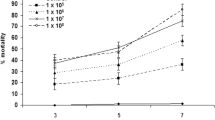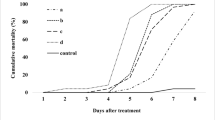Abstract
Twenty-three isolates of Metarhizium anisopliae (Metschnikoff) Sokorin and three isolates of Beauveria bassiana (Balsamo) Vuillemin (Ascomycota: Hypocreales: Clavicipitaceae) were assessed for their virulence against the two-spotted spider mite, Tetranychus urticae Koch (Acari: Tetranychidae). Based on the screening results, nine isolates of M. anisopliae and two isolates of B. bassiana were tested for their virulence against young adult (1- to 2-day-old) female T. urticae at constant temperatures of 20, 25, 30 and 35°C. At all temperatures tested, all the fungal isolates were pathogenic to T. urticae but mortality varied with isolates and temperatures. Fungal isolates were more virulent at 25, 30 and 35°C than at 20°C. The lethal time to 50% mortality (LT50) and lethal time to 90% mortality (LT90) values decreased with increased temperature. There were no significant differences in virulence between fungal isolates at 30 and 35°C; however, significant differences were observed at 20 and 25°C.
Similar content being viewed by others
References
Jeppson LR, Keifer HH, Baker EW. Mites injurious to economic plants. Berkeley: University of California Press; 1975. 614 pp.
Smith Meyer MKP. Mite pests and their predators on cultivated plants in southern Africa vegetables and berries. Plant Protection Research Institute. Handbook no. 6. Pretoria: ARC-Plant Protection Research Institute; 1996. 175 pp.
Bolland HR, Gutierez J, Flechtmann CHW. World catalogue of the spider mite family (Acari: Tetranychidae). Leiden: Brill NV; 1998. 392 pp.
Cranham JE, Helle W. Pesticide resistance in Tetranychidae. In: Helle W, Sabelis MW, editors. Spider mites, their biology, natural enemies and control, vol. 1B. Amsterdam: Elsevier; 1985. p. 405–22.
Hoy MA. Myths, models and mitigation of resistance to pesticides. Phil Trans R Soc Lond B Biol Sci. 1998;353:1787–95.
Herron GA, Rophail J, Wilson LJ. Chlorfenapyr resistance in two-spotted spider mite (Acari: Tetranychidae) from Australian cotton. Exp Appl Acarol. 2004;34:315–21.
Van de Vrie M. Control of Tetranychidae in crops: greenhouse ornamentals. In: Helle W, Sabelis MW, editors. Spider mites, their biology, natural enemies and control, vol. 1B. Amsterdam: Elsevier; 1985. p. 273–84.
de Moraes GJ, McMurtry JA. Comparison of Tetranychus evansi and T. urticae (Acari: Tetranychidae) as prey for eight species of Phytoseiid mites. Entomophaga. 1985;30:393–7. doi:10.1007/BF02372345.
Escudero LA, Ferragut F. Life-history of predatory mites Neoseiulus californicus and Phytoseiulus persimilis (Acari: Phytoseiidae) on four spider mite species as prey, with special reference to Tetranychus evansi (Acari: Tetranychidae). Biol Control. 2005;32:372–84. doi:10.1016/j.biocontrol.2004.12.010.
Oliveira H, Jansen A, Pallini A, Venzon M, Fadini M, Duarte V. A phytoseiid predator from the tropics as potential biological control agent for the spider mite Tetranychus urticae Koch (Acari: Tetranychidae). Biol Control. 2007;42:105–9. doi:10.1016/j.biocontrol.2007.04.011.
Gerson U, Smiley RL, Ochoa R. Mites (Acari) for pest control. Oxford: Blackwell; 2003. p. 539.
Collier KFS, Albuquerque GS, Lima JOG, Pallini A, Molina-Rugama AJ. Neoeiulus idaeus (Acari: Phytoseiidae) as a potential biocontrol agent of the two-spotted spider mite, Tetranychus urticae (Acari: Tetranychidae) in papaya: performance on different prey stage-host plant combinations. Exp Appl Acarol. 2007;41:27–36. doi:10.1007/s10493-006-9041-2.
Chandler D, Davidson G, Pell JK, Ball BV, Shaw K, Sunderland KD. Fungal biocontrol of Acari. Biocontrol Sci Technol. 2000;10:357–84. doi:10.1080/09583150050114972.
Van der Geest LPS, Elliot SL, Breeuwer JAJ, Beerling EAM. Diseases of mites. Exp Appl Acarol. 2000;24:497–560. doi:10.1023/A:1026518418163.
Tamai MA, Alves SB, Almeida JEM, Faion M. Evaluation of entomopathogenic fungi for control of Tetranychus urticae Koch (Acari: Tetranychidae). Arq Inst Biol. 2002;69:77–84.
Chandler D, Davidson G, Jacobson RJ. Laboratory and glasshouse evaluation of entomopathogenic fungi against the two-spotted spider mite, Tetranychus urticae (Acari: Tetranychidae), on tomato, Lycopersicon esculentum. Biocontrol Sci Technol. 2005;15:37–54. doi:10.1080/09583150410001720617.
Inglis DG, Goettel SM, Butt TM, Strasser H. Use of hyphomycetes fungi for managing insect pests. In: Butt TM, Jackson C, Magan N, editors. Fungi as biocontrol agents: progress, problems and potential. Wallingford: CABI International; 2001. p. 23–69.
Benz S. Environment. In: Fuxa JR, Tanada Y, editors. Epizootiology of insect diseases. New York: Wiley; 1987. p. 177–214.
Ekesi S, Maniania NK, Ampong-Nyarko K. Effect of temperature on germination, radial growth and virulence of Metarhizium anisopliae and Beauveria bassiana on Megalurothrips sjostedti. Biocontrol Sci Technol. 1999;9:177–85. doi:10.1080/09583159929767.
Tefera T, Pringle K. Germination, radial growth, and sporulation of Beauveria bassiana to Chilo partellus (Lepidoptera: Pyralidae) at different temperatures. Biocontrol Sci Technol. 2003;13:699–704. doi:10.1080/0958315031000151756.
Dimbi S, Maniania NK, Lux SA, Mueke JM. Effect of constant temperatures on germination, radial growth and virulence of Metarhizium anisopliae to three species of African tephritid fruit flies. Biocontrol. 2004;49:83–94. doi:10.1023/B:BICO.0000009397.84153.79.
Burgerjon A. Pulvérisation de poudrage au laboratoire par des préparations pathogènes insecticides. Ann Epiphyt. 1956;4:677–88.
Abbott WS. A method of computing the effectiveness of an insecticide. J Econ Entomol. 1925;18:265–7.
SAS Institute. SAS/STAT user’s guide, version 8.01. Cary: SAS Institute Inc.; 1999–2001.
Stokes ME, Davis CS, Koch GG. Categorical data analysis using the SAS system. Cary: SAS Institute, Inc.; 2000.
Samish M, Gindin G, Alekseev E, Glazer I. Pathogenicity of entomopathogenic fungi to different developmental stages of Rhipicephalus sanguineus (Acari: Ixodidae). J Parasitol. 2001;87:1355–9.
Dimbi S, Maniania NK, Lux SA, Ekesi S, Mueke JK. Pathogenicity of Metarhizium anisopliae (Metsch.) Sokorin and Beauveria bassiana (Balsamo) Vuillemin, to three adult fruit fly species: Ceratitis capitata (Weidemann), C. rosa var. gesciventris Karsch and C. cosyra (Walker) (Diptera: Tephritidae). Mycopathologia. 2003;156:375–81. doi:10.1023/B:MYCO.0000003579.48647.16
Wekesa VW, Maniania NK, Knapp M, Boga HI. Pathogenicity of Beauveria bassiana and Metarhizium anisopliae to the tobacco spider mite Tetranychus evansi. Exp Appl Acarol. 2005;36:41–50. doi:10.1007/s10493-005-0508-3.
Alves SB, Rossi LS, Lopes RB, Tamai MA, Pereira RM. Beauveria bassiana yeast phase on agar medium and its pathogenicity against Diatraea saccharalis (Lepidoptera: Crambidae) and Tetranychus urticae (Acari: Tetranychidae). J Invertebr Pathol. 2002;81:70–7. doi:10.1016/S0022-2011(02)00147-7.
Simova S, Draganova S. Virulence of entomopathogenic fungi to Tetranychus urticae Koch (Tetranychidae, Acarina). Rasteniev’dni Nauki. 2003;40:87–90.
Irigaray FJS, Marco-Mancebon V, Perez-Moreno I. The entomopathogenic fungus Beauveria bassiana and its compatibility with triflumuron: effects on the two-spotted spider mite, Tetranychus urticae. Biol Control. 2003;26:168–73. doi:10.1016/S1049-9644(02)00123-8.
Soper RS, Ward MG. Production, formulation and application of fungi for insect control. In: Papavizas GC, editor. Biological crop production. Montclair: Allanheld Osmum; 1981. p. 161–80.
Fargues J, Ouedraogo A, Goettel MS, Lomer CJ. Effects of temperature, humidity and inoculation method on susceptibility of Schistocerca gregaria to Metarhizium flavoviride. Biocontrol Sci Technol. 1997;7:345–57. doi:10.1080/09583159730758.
Acknowledgements
We thank Ms E.O. Ouna, Mr R. Rotich and Mr B. Muia for technical assistance. This study received financial support from the SII-Dutch government fund through the African Regional Postgraduate Programme in Insect Science (ARPPIS) of ICIPE and from the German Federal Ministry for Economic Cooperation and Development (BMZ).
Author information
Authors and Affiliations
Corresponding author
Rights and permissions
About this article
Cite this article
Bugeme, D.M., Knapp, M., Boga, H.I. et al. Influence of Temperature on Virulence of Fungal Isolates of Metarhizium anisopliae and Beauveria bassiana to the Two-Spotted Spider Mite Tetranychus urticae . Mycopathologia 167, 221–227 (2009). https://doi.org/10.1007/s11046-008-9164-6
Received:
Accepted:
Published:
Issue Date:
DOI: https://doi.org/10.1007/s11046-008-9164-6




